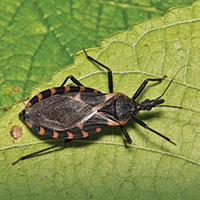 Chagas: Is this parasitic disease a problem here?
Chagas: Is this parasitic disease a problem here?
STORY BY LISA ZAHNER (Week of September 11, 2025)
The Centers for Disease Control on Sept. 9 declared Chagas disease endemic in the United States, and University of Florida researchers say more than 18,000 Floridians have been infected along with millions worldwide.
But is this potentially fatal disease here in Vero Beach? Zero local data seems to be available.
Are there any current cases of Chagas disease locally? Have we ever had any serious cases of Chagas disease in Vero? Has anyone died from Chagas locally? Nobody seems to have a ready answer.
“Chagas is a non-reportable disease in Florida, therefore the Florida Department of Health does not track human cases of the disease,” Indian River County Health Department spokesperson Stacy Brock said.
Requests sent last week to Cleveland Clinic Indian River Hospital and Orlando Health Sebastian River Hospital for local data on Chagas disease got no response as of press time.
Chagas is caused by the T. cruzi parasite and spread by the triatomine insect nicknamed the “kissing bug,” which is found in at least 32 Southern states. Four of the 11 triatomine species which carry the offending parasite are routinely infest indoor spaces in hot climates.
The first Florida kissing bug was documented in Gainesville in 1988, and from 2013 to 2023, the University of Florida studied the bugs in 23 counties.
The parasite appears to not favor any particular age or ethnic demographic, lending itself to the hypoendemic label, but risk factors include rural residence, a history of hunting or camping, and agricultural or outdoor work.
The latest U.F. Health prognosis for Chagas states, “About one third of infected people likely develop chronic or symptomatic Chagas disease. It can take more than 20 years from the time of the original infection to develop chronic illness, typically heart or gastrointestinal dysfunction. Abnormal heart rhythms may cause cardiac arrest and sudden death. Those who develop heart failure without management or heart transplant, usually die within several years.”
Chagas is endemic in 21 countries, and for the past 18 years, U.S. blood donations have been screened for it. Animals ranging from cats to raccoons to armadillos and horses can be infected, and Texas documented 431 canine cases from 2013-2015. Studies and reports cited in the FDOH literature are 15 to 20 years old.
Those numbers are so old because, apparently, the paperwork on Chagas disease in animals and humans got way too time-consuming so most reporting requirements were jettisoned.
Brock referred Vero Beach 32963 to the Florida Department of Health Chagas page, says:.
“It is estimated that as many as 8 to 11 million people in Mexico, Central America and South America have Chagas disease. Most people are asymptomatic and do not know they are infected. However, approximately 20 to 30 percent of those with chronic infection will develop clinically apparent disease, making it a significant public health concern.”
The parasite can be found on fruit from Central or South America that the bug has come in contact with, but so far not on U.S.-grown fruit. Symptoms may not be specific at first, often a feverish or off feeling. Patients may have swelling on the skin, especially if the infection point was the eyes.
“Once transmission has taken place, most infected individuals experience an acute illness phase with mild symptoms or nonspecific febrile illness that frequently goes unrecognized. After four to eight weeks or more, individuals enter the chronic phase and parasites are generally not detected in the blood. Without treatment, they will remain infected for life,” FDOH says.
There’s no single, rapid test for it, with at least two positive antibody tests over time required to declare a human Chagas case. In acute Chagas disease, the parasite may be detected in the blood under a microscope, the CDC says.
Medicines to treat Chagas are distributed by the CDC directly to doctors.
The new endemic designation – meaning “the constant presence/usual prevalence of a disease or infectious agent in a population within a geographic area” – will hopefully improve data collection and reporting on Chagas.
The new endemic designation, with a further recommendation for a hypo-endemic label emphasizes “the need for heightened awareness and surveillance.”
“We recognize the burden of locally acquired human disease in the United States does not approach the levels seen in some regions of Latin America, but hope that labeling the United States as Chagas disease-endemic will also raise awareness for this neglected disease across its endemic range,” the CDC said last week.
“This reclassification reflects a broader understanding of epidemiology that aligns with a One Health approach, recognizing the interconnectedness of human, animal, and environmental health. It also acknowledges the United States’ foundational and ongoing dependence on the highly variable modes of human migration and settlement.”
Eight states have begun or resumed tracking Chagas cases through public health departments, but in Florida, the University of Florida School of Medicine has gotten out ahead on Chagas, with UF Associate Professor Dr. Norman Beatty authoring the latest CDC guidance white paper along with researchers from Texas A&M University.



